Laem Phak Bia, Phetchaburi, Thailand
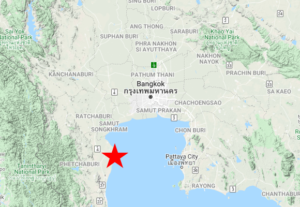
Probably the most productive of the three well-known shorebird sites southwest of Bangkok, Laem Phak Bia is especially good for longer-legged species including the rarities Asian Dowitcher and Nordmann’s Greenshank. The site also features a 3-km sandspit that is one of very few places in the world where the rare, recently rediscovered White-faced Plover has been found consistently, along with Malaysian Plover, Pacific Reef-Heron, Chinese Egret, and sometimes unusual gulls and terns.
Orientation
Directions
Laem Pak Bia is approximately two hours and 15 minutes’ drive (125 km) southwest of Bangkok. There are ways to reach it, approximately equivalent in time, but different in distance and point of arrival. The shorter route, on smaller roads, arrives at the north end, whereas the longer route uses faster roads and arrives at the south end.
To arrive from the north from Bangkok, take Route 35 west for 75 km to Samut Songkhram, then turn south onto Route 2021 toward Bang Kabun and follow the main coastal road southward. The road number changes to 4012 and after about 45 km south of Route 35 it reaches the village of Laem Pak Bia.
To arrive at the south end, starting from Bangkok, take Route 85 west for 85 km, where it feeds into Route 4. Take the southbound exit toward Phetchaburi then go about 35 km into the small city of Phetchaburi. Turn left following the signs indicating Had Chao Samran. After 600 m, turn left onto Route 1005, go 1.5 km, then turn left onto Route 3177. This road goes directly to Had Chao Samran, but just prior to that (15 km from Route 1005) it reaches a junction with Route 4012. Turn left here toward Laem Pak Bia.
Birdfinding
Laem Pak Bia offers several areas to explore, enough for a full day, though most visitors combine this site with Pak Tha Le, approximately 12 km north, which is more reliable for certain shorebirds.
Birdwatchers have recognized Laem Pak Bia as a hotspot for decades, and during that time the habitat quality and access to certain areas have declined, but it remains extremely productive overall. Two areas are of particular interest for wintering shorebirds: the sandspit for which the site is named; and the salt pans and lagoons north of the village.
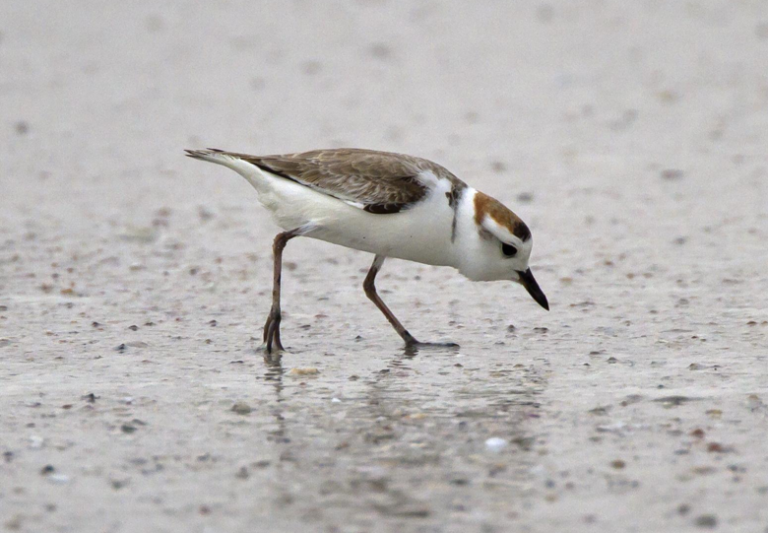
The sandspit at Laem Pak Bia is one of the few places where White-faced Plover can be found reliably. © Marco Valentini
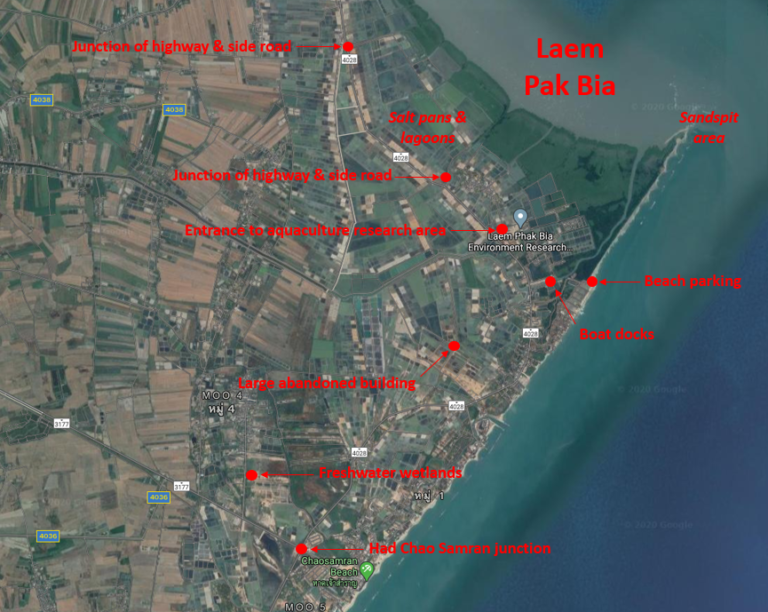
To add to the diversity, three other areas are worth considering: the “King’s Project” aquaculture and environmental research center; the “abandoned building” wetlands; and an area of freshwater wetlands just inland from the well-known beaches of Had Chao Samran a few km to the south.
Sandspit. The sandspit at Laem Pak Bia is a reliable site for both White-faced and Malaysian Plovers, usually in company of typical Kentish Plovers for a handy comparison. White-faced and Kentish Plovers are winter visitors, arriving in November and departing in March. Other species of special interest include Chinese Egret, Pacific Reef-Heron, and several terns including Great Crested and sometimes Lesser Crested.

Laem Pak Bia is the northwesternmost point where Malaysian Plover is resident. © J.J. Harrison
Reaching the sandspit requires either hiring a boat or walking a hot 3 km stretch of beach. Most visitors hire a boat, usually a boatman named Mr. Daeng who knows exactly where to find the birds of interest. The established fee is 1,000 baht (approximately U.S. $30). Other boatman are also available as an alternative, and eventually more of them will likely gain the experience to take visitors to the birds.
For those who prefer to walk or have difficulty arranging a boat, there is a convenient parking area beside the beach. The hike takes around 45 minutes to an hour each way, and is difficult or impossible at high tide.

Chinese Egret winters in small numbers at Laem Pak Bia. © Dave Bakewell
The boatride is preferable because it is easier, faster, and more productive as it follows a narrow mangrove-lined estuary and gives access to some sandbars and mudflats that cannot be viewed from land. In recent years, one or two Chinese Egrets have wintered on these mudflats, and multispecies flocks of terns roost on the sandbars. Pacific Reef-Herons can usually be found on rocky breakwaters near the end of the sandspit.
Salt Pans. The coastal flats are largely dedicated to salt farming, and there may be many productive sites tucked away in their midst. Most birdwatchers focus on a particular set of salt pans and adjacent lagoons just north of Laem Pak Bia, where large flocks of Great Knot and Black-tailed and Bar-tailed Godwits winter, along with representatives of most of Thailand’s other migratory shorebird species, including Asian Dowitcher and Nordmann’s Greenshank.
To explore this area, take Route 4028 approximately 1 km north of the temple and look for a well-traveled side-road on the coastal side. This road passes beside many salt pans and lagoons, then rejoins Route 4028 after a few km.
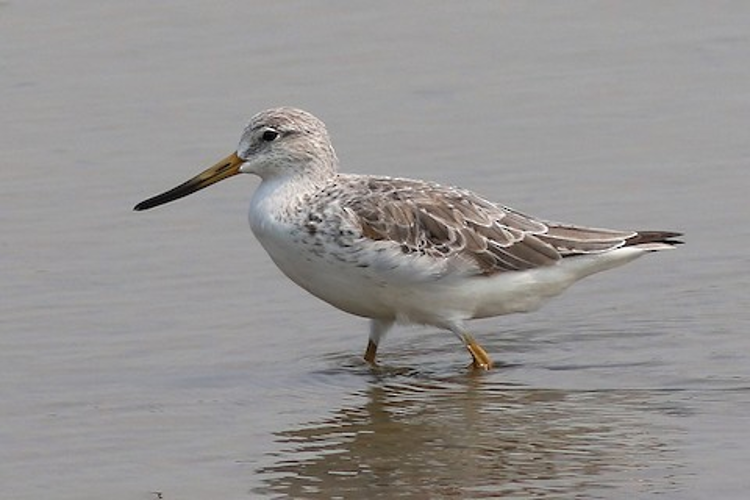
Flocks of Nordmann’s Greenshank winter in the salt pans north of Laem Pak Bia. © SteveM
“King’s Project” Research Center. Within the village, the temple Wat Samut Kodom is also the entrance to a set of salt pans and lagoons that are managed for aquaculture research. This area’s heyday has passed, but it may still be of interest to some visitors, or perhaps conditions will change and it will be re-established as a destination.
The main drawbacks in recent years have been access restrictions and vegetation removal. Vehicular access is prohibited, and entry on foot is now permitted only between 8:00 and 6:00, and requires signing in and surrendering an identification document to the gate office. Vegetation throughout the area is managed, and therefore subject to change, but the recent trend has been to reduce it, which has diminished the diversity of birds.
Species that can still be found here at the right season include Ruddy-breasted Crake, Slaty-breasted Rail, Ruff, Long-toed and Temminck’s Stints, Common and Pintail Snipes, and Common, White-throated, Black-capped, and Collared Kingfishers.

Large flocks of Great Knot winter in the salt pans at Laem Pak Bia. © Nigel Voaden
“Abandoned Building” Wetlands. On Route 4028 about 3 km south of Wat Samut Kodom, a side-road leads inland past a small garbage dump and on into an area of salt pans where the skeleton of a multistory structure looms darkly for no apparent reason.
The salt pans and other ponds in this area often host flocks of shorebirds. Although the diversity and numbers are usually much lower than in the salt pans described above, this area can sometimes produce a few different species, often including Asian Dowitcher, and less often rarities such as Spoon-billed Sandpiper and Nordmann’s Greenshank.
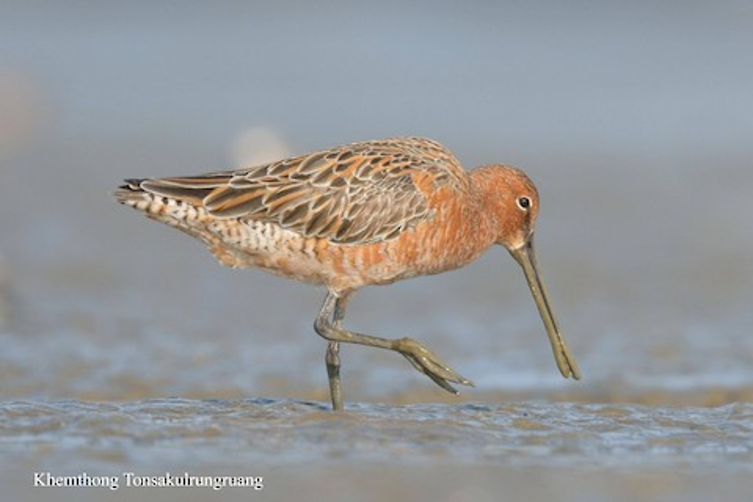
Flocks of Asian Dowitcher winter in salt pans around Laem Pak Bia. © Khemthong Tonsakulrungruang
The surrounding habitat includes some sparse brushy growth that has a history of attracting uncommon starlings: White-shouldered occurs regularly in winter, and rarer species including Brahminy, Daurian, and Rosy have been found on several occasions.
Had Chao Samran Wetlands. At the southern end of the Laem Pak Bia area, just inland from the beach at Had Chao Samran, is a set of shallow freshwater ponds that attracts ducks in winter. Garganey seems to be the predominant species, but several others have occurred, often including Ruddy Shelduck.
The habitat within and around these ponds is degraded, and they would not make a compelling target destination, but they are worth a stop along the way. In addition to ducks, they often teem with wading birds, and the surrounding brush sometimes produces unusual landbirds, including White-shouldered Starling.
These ponds are along a side-road north of Route 3177 about 1 km west of Route 4028. The ponds are on the east side of the side-road a few hundred meters north of Route 3177.
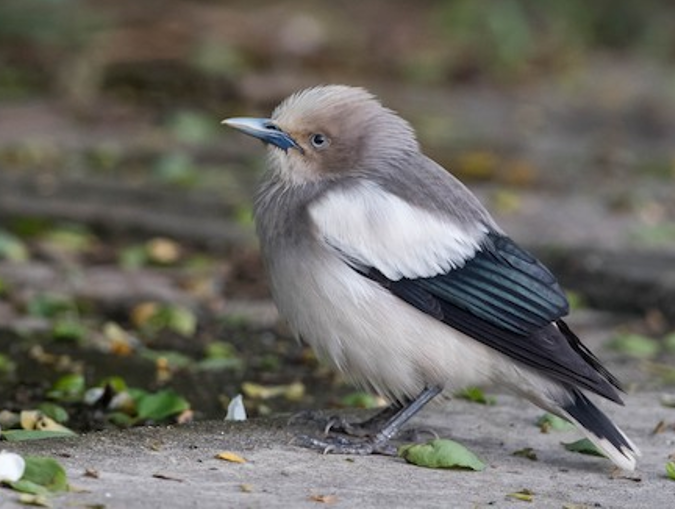
White-shouldered Starling is an uncommon but regular winter visitor in brushy areas around Laem Pak Bia. © Kai Pflug
Notes
When to Visit
Most of the sought-after species for which Laem Pak Bia is known are migrants and winter visitors. White-faced Plover is reliably present from December through February, and often into March.
Links